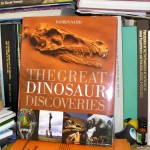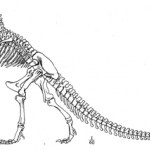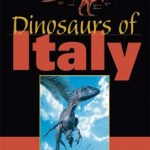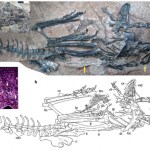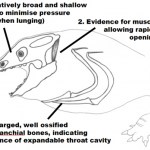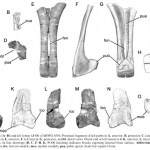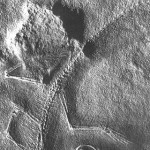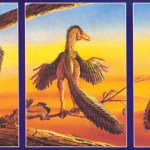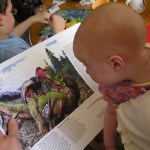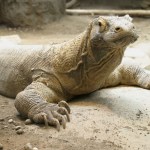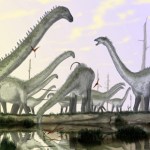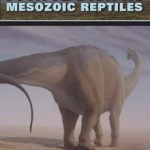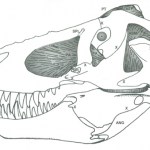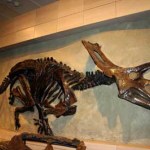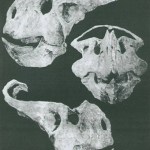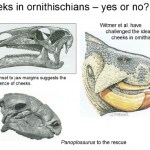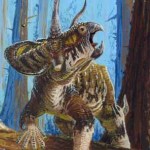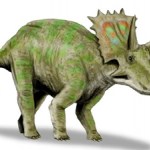Mesozoic dinosaurs
This work comes out in a few months though, as you can guess, I have my own advance copy already...
Much more in due time. As before, see if you can identify any of the other works visible (just about) on the shelves. Some are easier than others!
UPDATE: Well done if you had a go at guessing the books visible in the shot above. Yes, that's The Dinosauria (softback 1992) and Paul's Dinosaurs of the Air at far left, with Matt Wedel's 2007 PhD thesis Postcranial Pneumaticity in Dinosaurs and the Origin of the Avian Lung sandwiched in between. The slim, white and blue volume to the left of Matt'…
A little while ago, news of a new paper by Devon Quick and John Ruben, both of Oregon State University, appeared on the newswires. It got its fair share of publicity.
Entitled 'Cardio-pulmonary anatomy in theropod dinosaurs: implications from extant archosaurs', the paper (Quick & Ruben 2009) purports to show that modern birds are fundamentally different from non-avian dinosaurs in terms of abdominal soft-tissue morphology, ergo birds cannot be modified dinosaurs. In slightly more detail, the paper asserts that a specialised 'femoral-thigh complex', combined with a synsacrum and…
I'm really suffering from lack of time, so here's another book review (first published in 2005, so with a few updates added here and there)...
Lacking the Mesozoic dinosaur record of Britain, France, Germany, Portugal or Spain, our Italian colleagues have long had to make do with Triassic marine reptiles, Cretaceous squamates, and assorted Neogene mammals... not that there's anything wrong with that of course. Three interesting new dinosaur taxa, and a host of footprint discoveries, have changed all that however, and today Italy clearly has something quite important to say about the…
Oh, what the hell: given that we've already covered a new Wealden theropod, and have looked a bit at the palaeobiology of Majungasaurus within the week, I may as well resist my urge not to do more dinosaurs. In other words, I may as well cover Limusaurus as well, despite my previous protestations. It is, after all, a pretty incredible animal. Limusaurus is a small, long-legged dinosaur with short, gracile forelimbs, tiny hands, a slender neck and tail, a short, deep skull, and a slender lower jaw with a down-curved tip. It is toothless, and beak tissue is preserved around its jaw margins.…
I've had no time to complete any new articles, and after the text you're reading now - originally intended to be a comment appended to Cute, furry, has claws, bites - got to reasonable length, I thought I may as well turn it into a brief article. I'm still not sure how a long thread on identifying a rodent became subverted by a discussion on Cretaceous theropods, but anyway... [adjacent image from Andrea Cau's Theropoda]
If you followed the comments, you'll know that several Tet Zoo regulars (including Michael Ericson, Zach Miller and Thomas Holtz) have been discussing the possibility that…
I think I said recently that there have been way too many dinosaurs on Tet Zoo lately. It isn't that I don't like dinosaurs: it's just that I aim to provide balance and, let's face it, writing about charismatic megafauna all the time - especially dead charismatic megafauna - doesn't help. However, I'm sure you'll all forgive me for discussing my own published research. Last week another new paper came out with my name on it; hey, I'm fourth author of four, but it all counts, right? It's on another new bloody dinosaur...
Given that I write on Tet Zoo about such diverse subjects as the global…
In the previous article we looked at the Birds Come First, or BCF, hypothesis. It goes without saying that BCF has not won acceptance in the community, nor - in fact - is it even familiar to the majority of archosaur workers. Here, we take a critical view of BCF: does it stand up, or does it fail?
To begin with, let me note that the underlying premise of BCF is fundamentally problematical: the idea that there is some sort of 'central trunk' (Olshevsky 1994, p. 42) or single, unbroken lineage that extended from the first stem-archosaur to the most recently evolved, modern bird. Old 'family…
A substantial amount of evidence demonstrates that birds are theropod dinosaurs, and that birds evolved during the Jurassic from small, feathered maniraptoran theropods closely related to dromaeosaurids and troodontids (known collectively as deinonychosaurs) [the small dromaeosaurid Microraptor shown in adjacent image]. The precise details of avian origins remain the subject of debate, and argument continues over whether proto-birds were tree climbers, leapers, terrestrial cursors, or combined some of these lifestyles. But because basal deinonychosaurs were small animals (not much different…
Here's a recent photo showing the proofs of one of my books. These particular pages (which focus on the 'dinosaur renaissance' of the 1960s and 70s) feature a Luis Rey piece: as usual, poor Tenontosaurus is getting dispatched by a Deinonychus gang. As you can see, Emma thought the picture looked neat (Will plays with Lego power miners in the background. The photo has already been featured here at Querencia)...
I sent the photo round to a few friends. Comments so far have included "I think it's more she is querying the extent of feathering, surely?", "That is beautiful * you will get it…
The proofs for one of my books arrived the other day, so I have been busy busy busy. This (in part) explains the lack of action here on the blog, and the preponderance of recycled stuff. Sorry about that. In fact, sorry, here's another recycled article from Tet Zoo ver 1. Hopefully I'll have the time to produce some new content over the next week, but don't hold your breath. And sorry about all the dinosaur stuff: I know you much prefer it when I post on frogs, lizards, mice and passerines. Anyway...
As a kid I always got the impression from textbooks that the only tetrapods (and thus only…
Today sees the publication of a new paper by Michael P. Taylor, Mathew Wedel and myself in which we make a bold and controversial claim: based on data from living animals, we contend that the necks of sauropod dinosaurs - all sauropod dinosaurs - were most likely held habitually in erect poses, and not in horizontal or sub-horizontal poses (Taylor et al. 2009). This research should of course be significant if you're interested in knowing what sauropods looked like when they were alive. However, it also impacts on hypotheses about sauropod behaviour, physiology and ecology [image below by the…
No time to produce anything new, so here's another recycled book review...
While the Mesozoic strata of Patagonia are particularly well known for their diverse and often spectacular dinosaurs, they have also yielded a phenomenally rich record of other Mesozoic reptiles, including turtles, squamates, plesiosaurs, ichthyosaurs, crocodilians and pterosaurs. In this multi-authored volume (another contribution to Indiana University Press's Life of the Past series), Gasparini, Salgado and Coria have edited a collection of 14 papers on the region's Mesozoic reptiles, and on their geological context…
Few dinosaurs are as well studied as the Upper Cretaceous tyrannosaurid theropod Tyrannosaurus rex. It might be easy to assume that this intense focus has been driven by the fame and glory associated with working on this dinosaur. That might be partly true but, in fact, T. rex really is one of the best known dinosaurs, represented by multiple individuals that are often near-complete and well preserved. It has also - in the form of bite marks, coprolites and soft tissue traces (or alleged soft tissue traces) - left us more evidence of its behaviour than many other Mesozoic dinosaurs. T. rex…
A little while ago - that is, during Ceratopsian Week - I discussed NMC 8538, the excellent articulated Anchiceratops ornatus specimen today displayed at the Canadian Museum of Nature in Ottawa. Alas, while photos of the panel-mounted specimen were published by Lull (1933) and also by David Norman in his The Illustrated Encyclopedia of Dinosaurs, they're small and I don't have access to hi-res versions. Well, today we owe a substantial debt of gratitude to ReBecca Hunt-Foster of Dinochick Blogs for - ta-dah! - heeeeeeere's NMC 8538....
As mentioned before, the specimen shows that…
As you'll know if you've already seen the announcement over at SV-POW!, my friend and co-author Mike P. Taylor successfully defended his Ph. D. yesterday: congratulations again, Mike. Mike's thesis was titled Aspects of the History, Anatomy, Taxonomy and Palaeobiology of Sauropod Dinosaurs: its contents (listed here) will soon see publication; indeed, some chapters are already published (Taylor & Naish 2007) or in press.
Here, Mike shakes hands with Eric Buffetaut (his external examiner) while a very jovial Andy Gale (his internal examiner; he looks suspiciously like Eddie Izzard in this…
I never planned to do a whole week on ceratopsians: the initial idea was just to recycle some of those field guide texts in order to save a bit of time. But, oh well, Ceratopsian Week took on a life all its own. To finish things off, we're going to look at some tremendously obscure ceratopsians: they're reasonably familiar to dinosaur uber-nerds/dinosaur experts, of course, but are unheard of outside of the dinosaur community.
We begin with Protoceratops hellenikorhinus Lambert et al., 2001 [shown here] from the Campanian of Bayan Mandahu, Inner Mongolia. P. hellenikorhinus is similar to the…
What with yesterday's article on an 'alternative look' for ceratopsians, here's another one. The image used here (again, a powerpoint slide from one of my talks) is pretty self-explanatory, and I use it here because Witmer and colleagues (Papp 1997, Papp & Witmer 1998) used the leptoceratopsid ceratopsian Leptoceratops as their examplar...
Did Leptoceratops (and other ceratopsians, and other ornithischians) really look like this? That is, with keratinous tissue extending along the jaw margins and 'cheeks' being absent (and by 'cheeks' I mean sheets of tissue enclosing the lateral…
One of the most distinctive features of ceratopsian dinosaurs is the conspicuous bony frill, formed from the parietal and squamosal bones, that projected backwards (and sometimes upwards too) from the rear margin of the skull.
Typically decorated around their edges by semi-circular bones called epoccipitals, and sometimes sporting horns, spikes or mid-line keels, frills were a fundamental part of the skull: this means that, whenever the animal moved its head up, or down, or to the side, the whole frill moved too. The fact that the ceratopsian occipital condyle is damn-near spherical shows…
So far we've looked at leptoceratopsids and chasmosaurine ceratopsids. This time, it's the turn of the basal ceratopsoid Zuniceratops. If these terms are giving you grief, a cladogram showing a few of them is below...
Zuniceratops christopheri [adjacent life restoration by Todd Marshall] was named in 1998 by Douglas Wolfe and Jim Kirkland for several specimens discovered in the Turonian Moreno Hill Formation of New Mexico. Its generic name honours the Zuni people, while its specific name is for Christopher Wolfe, co-discoverer of the first specimen. In many features Zuniceratops was…
Another obscure ceratopsian from the defunct field guide project: for the back story go here and here.
A distinctive chasmosaurine similar in size to a large rhino (total length approximately 3.5 m), Anchiceratops ornatus was a heavily built species with a particularly short tail and robust limbs [adjacent image from wikipedia. Not bad, but it doesn't depict the rear margin of the frill or epoccipitals correctly]. Barnum Brown first discovered this species in 1912 in the Campanian Dinosaur Park Formation, and named it in 1914. Brown's specimen had long, erect brow horns, leading some to…
